This month we are highlighting a very interesting find from the Dental Library: Wit Love Frum Cousin Sylveste by Fred J. Wolfe D.D.S. This collection of original letters documents a small portion of the history of Louisiana dentistry, the Louisiana Dental Association, and Louisiana heritage.
Fred J. Wolfe D.D.S. was a New Orleans dentist who graduated from dental school in 1908 and established a practice on Canal Street. He served as President of the Louisiana Dental Association from 1927-1928. Beginning in the Summer of 1931, Dr. Wolfe authored letters published in Impressions, “A Journal of Friendly Relations published quarterly by the Louisiana State Dental Society”. The regular column, A Letter from Cousin Sylveste, detailed the state of Louisiana dentistry, the events that took place at Louisiana and national dental meetings, and daily life as a Louisiana dentist. Each letter was written in an irreverent Cajun dialect and pokes fun at the profession, meeting presenters, society leaders, and Louisiana culture. The last letter was published in the last issue of Impressions (1938 Summer: 7(3): 13-4) but Wit Love Frum Cousin Sylveste contains a special unpublished “Au Revoir frum Sylveste” letter dated May 18, 1939. The volume is signed by the author and many of the personalities who appear within the letters and was presented as a gift to the Louisiana State University School of Medicine Library in memory of Leo J. Schoeny, D.D.S.. an editor of the journal Impressions.
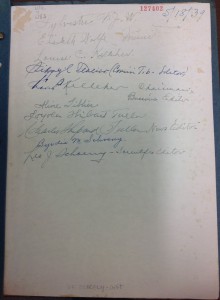
If you would like to take a look at this or any of the other special holdings in the Dental Library, please contact us. We are happy to show off our collection!

“Richard III, uncle of Elizabeth of York, great uncle of Henry VIII by Lisby in House of York, List of English monarchs, Richard III of England on Fotopedia – Images for Humanity ” by lisby1 is licensed under CC BY 2.0
Richard III reigned as King of England from 1483 until he was killed at the Battle of Bosworth Field in 1485, thus closing the final chapter of the decades-long Wars of the Roses and ushering in the age of the Tudors. He is one of more infamous monarchs in British history, with opinions ranging from him as the hunchback usurper who had his nephews murdered as popularized by Shakespeare, to that of a trustworthy person who was simply caught up in the battle for control of the English crown.* Aside from his interest to scholars and drama enthusiasts, we are finding more and more about Richard III the man and his medical conditions as a result of the discovery and continuing analysis of his remains.
As a defeated monarch, Richard III was not treated to a royal burial after his death. Rumors persisted throughout the centuries as to the fate of his body, and, incredibly, remains discovered during an archaeological dig under a car park in the city of Leicester and subsequent DNA analysis confirmed that Richard III had been found.
One of the most recent discoveries in the ongoing analysis of the remains affects the portrayal of his being a hunchback as described in Shakespeare’s Richard III. An article published in the May 31, 2014, issue of Lancet by Appleby, et al, reports that Richard suffered from adolescent idiopathic scoliosis, but not to such an extent to cause him to appear as the physically deformed monster of the play. According to the analysis, his mobility would not have been affected by the condition, and a clever tailor could even have compensated for any noticeable traces of it in his appearance.
For more information about Richard III, discovery of his remains, and the continuing analysis, please see:
*Full disclosure: the author of this post studied the pardons granted during the reign of Richard III and tends to take a sympathetic view of his legacy.
Whether you’re wrapping up a manuscript developed over the school year or preparing for a summer of research, you may be interested in June 12’s Library Lunchtime Learning session: Writing a Quality Abstract. Join us and learn why the abstract might be the most important part of an article and how to create an effective one that will catch the attention of potential readers.
If you plan to attend, please RSVP to dentlib@lsuhsc.edu; however, drop-ins are welcome!
Details:
- Writing a Quality Abstract
- June 12, 12-1 p.m.
- Room 6409, LSUSD
Circulation: cardiovascular quality and outcomes has a pre-print article that’s making the news. A Harvard developed an email based game that quizzes participants on the best ways to treat hypertension. The game is offered via QStream, a Harvard based tech company which offers educational programs.
While the LSUHSC Libraries do purchase a subscription to the listed journal, this particular article is available for free to the general public.
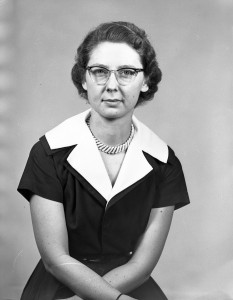
LSUHSC Portrait – probably mid 1950s to mid 1960s.
Rowena Spencer passed away at age 91 on Tuesday, May 13th. She will be remembered by generations of New Orleanians for her surgical skills, her commitment to various causes, her eccentricities, and most of all her dedication to the young patients she saved. She was a faculty member in the Department of Surgery (and later Pediatrics) from 1952 until about 1969.
This article appeared on NOLA.com this afternoon.
*Edit* 11:10 am and the problem has been fixed!
We noticed at just before 10 am this morning that our catalog, INNOPAC is acting up. Searching by New Orleans Collection by anything besides keyword is giving bad results.
While we work on the issue, please search using keyword only or search by the Entire Collection.
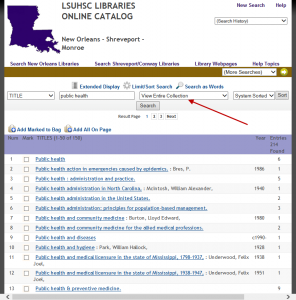
Example of Searching Entire Collection
In the continuing series “It came from the stacks”, I present to you three books from the Dental Library that are just fun. They don’t have any great historical significance and certainly don’t have scientific value to a student of dentistry, but who can resist a tale of the “tooth gremlin”?
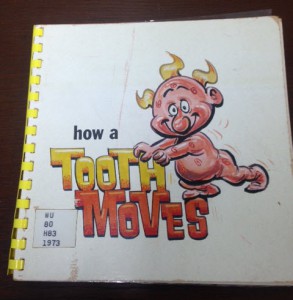
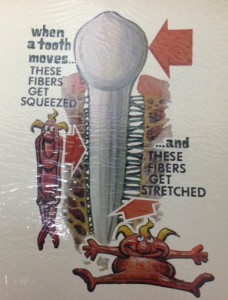
How a Tooth Moves, tells the story of “the orthodontist’s friend, the Tooth Gremlin”. Published in 1973, this picture book tells the story of a naked little gremlin who moves teeth during orthodontic treatment. He explains to children how the periodontal ligament is stretched on one side of the tooth and squeezed on the other causing the tooth to move and then bone is built up and the tooth stays in the new place. The book ends with the Tooth Gremlin reminding the reader that their headgear and elastics help move teeth too so “you do your part and I’ll do mine!” Curiously, a quick WorldCat query found that only two libraries have copies of this book: University of Sao Paulo, Brazil, and LSUHSC-NO.
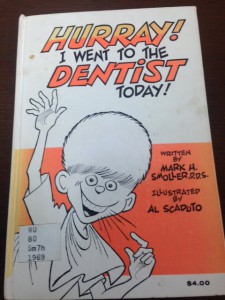
Another fun children’s book in the Dental Library is Hurray! I went to the Dentist Today by Mark Smoller, DDS. This picture book starts with this rhyme:
“HURRAY! I went to the dentist today
It was more fun than the games that I play.
We went to the dentist, my mother and me.
There were new things to do.
There were new things to see.”
It might not win any awards for poetry, but it does manage to describe several of the pieces of equipment a child will encounter in a dental office in rhyme.
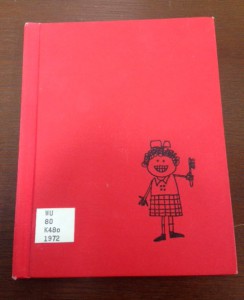
The last of our historical picture books for children is Our Tooth Story; a tale of twenty teeth by Ethel and Leonard Kessler. This 1972 book tells of Mrs. Wood’s kindergarten class who start to lose their teeth. Prompted by this, they read a story, “Our Tooth Story” which describes the students’ dentists’ offices and how to take care of their teeth.
While these books are all older and probably not the books you’d give to a child anymore, they are an interesting look back at pediatric dentists attempt to alleviate children’s fear of visiting the dentist and dental procedures. If you’d like to come take a look at these books or some of our other children’s books, please contact us or stop in to see us.
The National Library of Medicine houses the Michael Zwerdling Nursing Postcard Collection of nearly 2500 postcards, “published in the United States and internationally, depicting the nursing profession, the social history of nursing, the perception of nursing in various cultures, the role of military nurses, and other related themes.” The cards date from between 1893 and 2002. Approximately 600 of the postcards have been digitized by the Images from the History of Medicine section of the History of Medicine Division of NLM.

National Organizations of Nurses of the United States. New Orleans 1916 (http://ihm.nlm.nih.gov/luna/servlet/view/search?q=D05931)
 This is just a gentle reminder that our MDConsult access will expire on Sunday, 5/11/2014.
This is just a gentle reminder that our MDConsult access will expire on Sunday, 5/11/2014.
See our previous blog post here for more information: https://www.lsuhsc.edu/library/news/?p=9481.
The Library’s Faculty Publications display, located on the first floor of the Library, has been updated with eight new articles for the months of May and June. The new article array covers topics from alcohol intoxication’s impact on spinal injuries, to the linkage between schizophrenia and chronic LSD usage, to nursing in catastrophe.
LSUHSC-NO authors are shown in bold print:
- Crutcher CL, Ugiliweneza B, Hodes JE, Kong M, Boakye M. Alcohol intoxication and its effects on traumatic spinal cord injury outcomes. J Neurotrauma. 2014.
- Hong S, Alapure BV, Lu Y, Tian H, Wang Q. 12/15-lipoxygenase deficiency reduces densities of mesenchymal stem cells in the dermis of wounded and unwounded skin. Br J Dermatol. 2014.
- Leblanc KG, Jr, Monheit GD. Understanding and use of the American Joint Committee on Cancer seventh edition guidelines for cutaneous squamous cell carcinoma: A survey of dermatologic surgeons. Dermatol Surg. 2014.
- Martin DA, Marona-Lewicka D, Nichols DE, Nichols CD. Chronic LSD alters gene expression profiles in the mPFC relevant to schizophrenia. Neuropharmacology. 2014.
- Molina PE, Amedee AM, Lecapitaine NJ, Zabaleta J, Mohan M, Winsauer P, Vande Stouwe C, McGoey R, Auten MW, Lamotte L, Chandra LC, Birke L. Modulation of gut-specific mechanisms by chronic Delta9-THC administration in male rhesus macaques infected with simian immunodeficiency virus: A systems biology analysis. AIDS Res Hum Retroviruses. 2014.
- Park EP, Boulmay BC. Images in clinical medicine. herpes labialis and facial-nerve paralysis. N Engl J Med. 2014 ;370(11):1048.
- Polhemus DJ, Lefer DJ. Emergence of hydrogen sulfide as an endogenous gaseous signaling molecule in cardiovascular disease. Circ Res. 2014; 114(4):730-737.
- Sterling YM. Nursing ‘caring’ during catastrophic events: Theoretical, research, and clinical insights. Int J Human Caring. 2014; 18(1):60-65.
These articles are part of the Library’s Faculty Publications Database, which is maintained by Reference Librarian, Kathy Kerdolff. The database includes publications authored by LSUHSC-New Orleans faculty, researchers, and students since 1998. It is updated weekly with new articles harvested from a variety of citation sources: PubMed, Scopus, and CINAHL, etc.
The display highlights sixteen articles at a time, rotating eight new articles each month. You can find more information about the database and listings for our current and past displays from Library’s Faculty Publications landing page: http://www.lsuhsc.edu/library/databases/facpubs.aspx.
To add your faculty publications to the database and display, or for questions about either, please contact Kathy Kerdolff.
Tags: Faculty publications | Citation Managers, Faculty News, Neuroscience, New Find, Pharmacology, Physiology, Publication Alert, Tools | Permalink | Comments Off on Faculty Publications May Display | Posted Tuesday, May 6, 2014 by Phillips, Holland T.
The Office of Community and Minority Health Education at LSUHSC School of Medicine is now accepting entries for their essay contest: “What does being healthy mean to me?” The goal of this contest is to allow the children of South Louisiana “to exercise their natural inquisitive nature in exploring health and healthcare policy issues.”
Entries postmarked no later than May 9, 2014 will be accepted and the winners announced on May 17, 2014. First place winner will receive $750; second place winner will receive $500; third place winner will receive $250.
For eligibility and entry guidelines on words count requirements, submission address, judging breakdown, and contest entry form, please refer to http://www.medschool.lsuhsc.edu/essaycontest/.
An informational video has also been posted on YouTube:
Sponsors for this contest include the LSU Healthcare Network in partnership with LiveWell Louisiana and Winn-Dixie.
Doody’s Precision Search is not working. We will let you know when access has been restored.
The Isché Library is featuring 20 newly acquired books for the latter part of April and all of May. The subjects include nursing, physical therapy, occupational therapy, communication disorders, education, ethics, etc.
These books CAN be checked out!

New Books Display April/May 2014
Featured books include:
- Baker, Robert Before bioethics: a history of American medical ethics from the colonial period to the bioethics revolution W 50 B17 2013
- Cole, Steven A. The medical interview: the three function approach. [by] Steven A. Cole [and] Julian Bird. 3rd edition. WB 290 C67m 2014
- Occupational therapy for physical dysfunction / editors, Mary Vining Radomski, Catherine A. Trombly Latham. 7th ed. WB 555 T75o 2014
- Hassink, Sandra Gibson. Pediatric obesity: prevention, intervention, and treatment strategies for primary care. 2nd ed. WD 210 H27 2014
- McKinnis, Lynn N., 1959- Fundamentals of musculoskeletal imaging. 4th ed. WE 141 M21 2014
- Garrard, Judith. Health sciences literature review made easy: the matrix method. 4th ed. W 20.5 G19h 2014
- Innovations in nursing education: building the future of nursing. Edited by Linda Caputi. WY 18 C175b 2014
- Corr, Charles A. Death & dying, life & living. Charles A. Corr & Donna M. Corr ; with contributions from Tashel C. Bordere. 7th ed. BF 789.D4 C81d 2013
- Irwin, David (David L.) Clinical research methods in speech-language pathology and audiology. Mary Pannbacker, Norman J. Lass. 2nd ed. W 20.5 Ir9 2014
- Jones, David S. (David Shumway) Broken hearts: the tangled history of cardiac care. WG 300 J71 2013
- Iserson, Kenneth V. Iserson’s getting into a residency: a guide for medical students. 8th ed. W 20 Is2g 2013
- Fundamentals of hand therapy: clinical reasoning and treatment guidelines for common diagnoses of the upper extremity. Edited by Cynthia Cooper. 2nd ed. WE 830 C784 2014
- Fink, Sheri. Five days at Memorial: life and death in a storm-ravaged hospital. WX 28 AL6 F49 2013
- Tille, Patricia M. Bailey & Scott’s diagnostic microbiology. 13th ed. QW 25 B15d 2014
- Weiss, Donna (Donna F.) The interprofessional health care team: leadership and development. Donna Weiss, Felice J. Tilin, and Marlene J. Morgan. W 84.8 W43 2014
- Introduction to research in education. {by] Donald Ary [and others]. 9th ed. W 20.5 Ar9 2014
- Dysphagia assessment and treatment planning: a team approach / [Edited by] Rebecca Leonard [and] Katherine A. Kendall. 3rd ed. WI 250 L58 2014
- Adult audiologic rehabilitiation. [Edited by] Joseph J. Montano [and] Jaclyn B. Spitzer. 2nd ed. WV 270 M76 2014
- Alfaro-LeFevre, Rosalinda. Applying nursing process: the foundation for clinical reasoning / Rosalinda Alfaro-LeFevre. 8th ed. WY 100 AL28 2014
- Ralph, Sheila Sparks. Sparks and Taylor’s nursing diagnosis reference manual. Sheila Sparks Ralph [and] Cynthia M. Taylor. 9th ed. WY 100 Sp2n 2014
Happy Reading!
Thanks to other groups on campus, the Libraries have created pages for 2 funding sources available to all LSUHSC faculty, staff and students.
Grant Forward is the newly revised IRIS database and is provided by the LSUHSC New Orleans Office of Research Services.
SciVal Funding allows searching in the US and abroad and is provided by the Stanley S. Scott Cancer Center Office of Grants and Development.
Both databases are available on and off campus with the Libraries’ WAM access.
The problem that was preventing the links to the Library’s WebBridge Link Resolver from displaying in Google Scholar has been solved. In addition, you can now find us under the “Library Links” if you wish to configure the link resolver to work when using the site off-campus.
If you need more information about how to configure the WebBridge Link Resolver to work with Google Scholar, please refer to this post about Google Scholar and the link resolver.


 myLSUHSC
myLSUHSC








